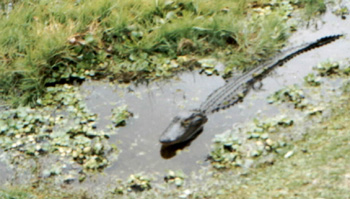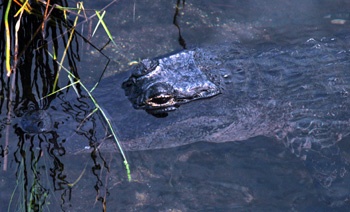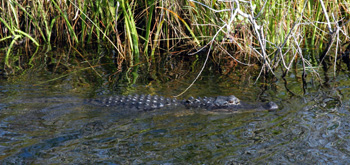
Florida alligators make big comeback
OCHOPEE, Fla. – Ever wonder what it would be like to describe what an alligator looked like to your son or daughter?
It was only 15 years ago when we almost lost them all. For good.
Less than two decades ago, many animals in the Everglades National Park and Big Cypress National Preserve took a heavy hit from extensive poaching and hunting. This led to many of the animals having to be placed on the endangered species lists with little hope for a future.
Poachers and hunters greedily and carelessly captured alligators, cranes, hawks, and water moccasins. According to the Environmental Protection Agency, in October of 1989, when American alligator numbers were at their lowest there were less than 200 of them living in the Everglades.
Today their numbers are strong and their future is looking brighter than ever, thanks to park officials, animal rights organizations, and better-educated park visitors.
“Their numbers about 10 years ago were devastating, many of us didn’t know what to think,” said Everglades National Park ranger Bridget Bellsy. “It’s nice to see them doing well.”
 |
Alligators love the waters of the Everglades (Staff photos). |
When the population problem became known, organizations like the Environmental Protection Agency got involved. Volunteers posted signs throughout the park and other assisted rangers in patrolling the parks in search of hunters.
The park also started teaching visitors about the animals in the park and how important it is to save them.
“The idea for that was to make people care about the animals so they would want to help them too,” said Bellsy.
Information about the animals and their population can be found at the park’s welcome center. Guided tours and hikes are additional ways for visitors to learn about the animals and their natural history.
Another way the animals were saved, was through the park’s partnership with universities and organizations that set up studies throughout the park. Nova Southeastern University has a large environmental and marine program and conducts studies on almost every plant and animal native to the park.
“Life out here is really serene and it is hard to imagine that anyone would want to disturb this graceful balance,” said Nova Southeastern University biologist Henry Goldstein.
Goldstein is currently conducting study on the park’s Apple snail population. These snails are the sole source of food for the Brown or Apple Hawk. These hawks were almost lost to hunting and bringing more of the snails to the environment has attracted more hawks, which has led to an increase in population.
“The balance is just so delicate that losing one creature is going to quickly lead to the demise of many more,” said Goldstein.
He tracks these snails by attaching radio transmitters to them and he can locate them within a certain radius of where he is located.
 |
A young alligator floats on the surface at Royal Palm’s Anhinga Trail. |
The Save the Everglades organization, stresses that it is always important to remember how delicate the balance of life is in our national parks.
While hunting has been the largest contributor to the decline in the wildlife populations, ORVs, or off-road vehicles, have damaged large portions of the wetland habitats as well.
The Everglades Protection Group, the Environmental Protection Agency, the Save the Everglades organization and dozens of other groups have tried to urge Florida legislature to take a stand on the issue.
“It just takes one careless rider to destroy a large patch of wetland territory,” said Goldstein. “Most of them just don’t care and they should just outlaw the use of them altogether.”
Outlawing the use of ORVs is not currently an option, however raising the charge to drive them through the park is. Right now a rider only has to pay $35 for a permit to ride in the park for one year. Environmental groups are pushing for $75. Most of the riders are probably not aware of the extreme damage that they are causing, but it is essential for them to make the effort to learn about the life in the park.
Going to the welcome center or talking to a ranger is an excellent way to start.
Outlawing the use of ORVs is not currently an option, however raising the charge to drive them through the park is. Right now a rider only has to pay $35 for a permit to ride in the park for one year.
 |
An alligator swims along the surface at Royal Palm’s Anhinga Trail. |
Environmental groups are pushing for $75. Most of the riders are probably not aware of the extreme damage that they are causing, but it is essential for them to make the effort to learn about the life in the park.
Going to the welcome center or talking to a ranger is an excellent way to start.
For more information about the animals in the Everglades and programs or guided tours, stop by the visitor center or sign on to http://www.nps.gov/ever/.
Thanks to better-educated visitors and people who care, it is not necessary to rehearse describing alligators to your children, however it is important to inform how important it is to save them, so they never have to worry in the future.
If You Go
- Address: Big Cypress National Preserve, HRC61, P.O. Box 110, Ochopee, Fla. 33943.
- Phone: 941-695-4111.
- Prices: $4 camping fee, $35 permit for ORVs.
- Hours: 8:30 a.m. to 4:30 p.m. year round, except Dec. 25, when welcome center is closed.

Comments are Closed